charging SUBARU SOLTERRA 2023 Owners Manual
[x] Cancel search | Manufacturer: SUBARU, Model Year: 2023, Model line: SOLTERRA, Model: SUBARU SOLTERRA 2023Pages: 628, PDF Size: 11.91 MB
Page 1 of 628

1
2
3
4
5
6
7
8
9
10
Owners Manual_USA_M42C01_en
Pictorial indexSearch by illustration
For safety
and securityMake sure to read through them
(Main topics: Child seat, theft deterrent system)
Electric Vehicle
systemReading charging-related information
(Main topics: Electric Vehicle system, charging methods)
Vehicle status
information and
indicatorsReading driving-related information
(Main topics: Meters, multi-information display)
Before driving
Opening and closing the doors and windows,
adjustment before driving
(Main topics: Keys, doors, seats)
Driving
Operations and advice which are necessary for driving
(Main topics: Starting Elect ric Vehicle system, driving
support systems)
Interior featuresUsage of the interior features
(Main topics: Air conditioner, storage features)
Maintenance
and careCaring for your vehicle and maintenance
procedures
(Main topics: Interior and exterior, light bulbs)
When trouble
arisesWhat to do in case of malfunction and emergency
(Main topics: 12-volt battery discharge, flat tire)
Vehicle
specificationsVehicle specifications, customizable features
(Main topics: Fluids, tire inflation pressure)
For ownersReporting safety defects for U.S. owners, and seat
belt, SRS airbag and headlight aim instructions for
Canadian owners
IndexSearch by symptom
Search alphabetically
Page 2 of 628
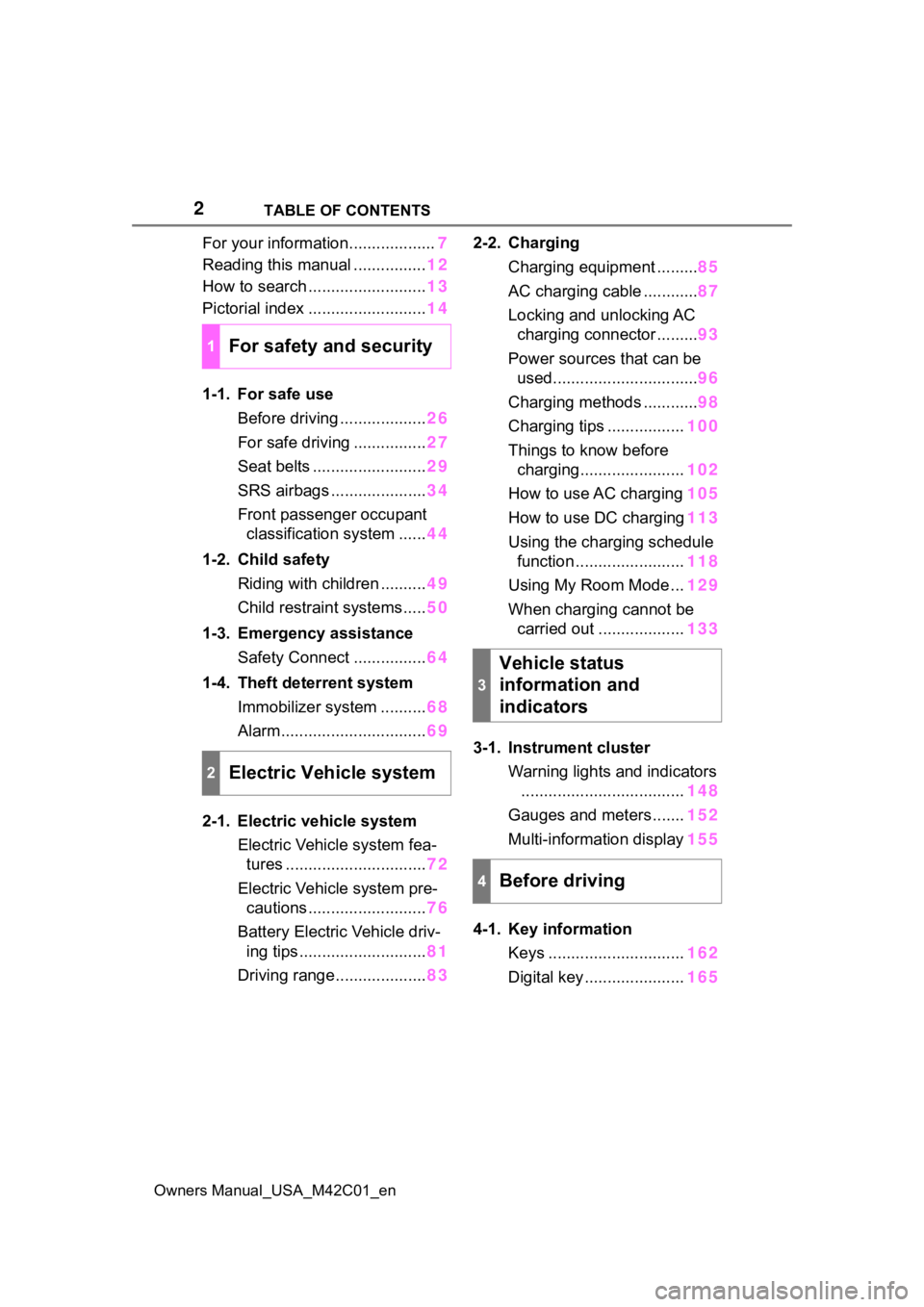
2
Owners Manual_USA_M42C01_enTABLE OF CONTENTS
For your information...................
7
Reading this manual ................ 12
How to search .......................... 13
Pictorial index .......................... 14
1-1. For safe use Before driving ................... 26
For safe driving ................ 27
Seat belts ......................... 29
SRS airbags ..................... 34
Front passenger occupant classification system ...... 44
1-2. Child safety Riding with children .......... 49
Child restraint systems..... 50
1-3. Emergency assistance Safety Connect ................ 64
1-4. Theft deterrent system Immobilizer system .......... 68
Alarm................................ 69
2-1. Electric vehicle system Electric Vehicle system fea-tures ............................... 72
Electric Vehicle system pre- cautions .......................... 76
Battery Electric Vehicle driv- ing tips ............................ 81
Driving range.................... 832-2. Charging
Charging equipment ......... 85
AC charging cable ............ 87
Locking and unlocking AC charging connector ......... 93
Power sources that can be used................................ 96
Charging methods ............ 98
Charging tips ................. 100
Things to know before charging....................... 102
How to use AC charging 105
How to use DC charging 113
Using the charging schedule function ........................ 118
Using My Room Mode ... 129
When charging cannot be carried out ................... 133
3-1. Instrument cluster Warning lights and indicators.................................... 148
Gauges and meters ....... 152
Multi-information display 155
4-1. Key information Keys .............................. 162
Digital key ...................... 165
1For safety and security
2Electric Vehicle system
3
Vehicle status
information and
indicators
4Before driving
Page 15 of 628

15Pictorial index
Owners Manual_USA_M42C01_en
Precautions against winter season .............................. ........ P.393
To prevent freezing (windshield wiper de-icer)
*.................... P.404
Precautions against car wash
(Rain-sensing windshield wipers)
*....................................... P.449
Charging port .................................................. ..................... P.85
Charging method ................................................ ................... P.98
Tires.......................................................... ........................... P.472
Tire size/inflation pressure ................................... ................ P.555
Winter tires/tire chain ........................................ ................... P.393
Checking/rotation/tire pressure warning system
*................. P.472
Coping with flat tires......................................... .................... P.527
Hood ........................................................... ......................... P.462
Opening ............................................................................... P.462
Coping with overheat ........................................... ................ P.545
Warning messages ............................................... ............... P.522
Headlights/daytime running lights .............................. ..... P.248
Parking lights ................................................. .................... P.248
Turn signal lights ............................................. .................. P.242
Front side marker lights ....................................... ............. P.248
Headlights..................................................... ...................... P.248
Parking lights/turn signal ligh ts/daytime running lights P.248
Tail lights.................................................... ......................... P.248
Turn signal lights ............................................. .................. P.242
Stop lights
Rear side marker lights ........................................ ............. P.248
Tail lights.................................................... ......................... P.248
Back-up light
Light bulbs of the exterior lights for driving
(Replacing method: P.502)
Page 70 of 628
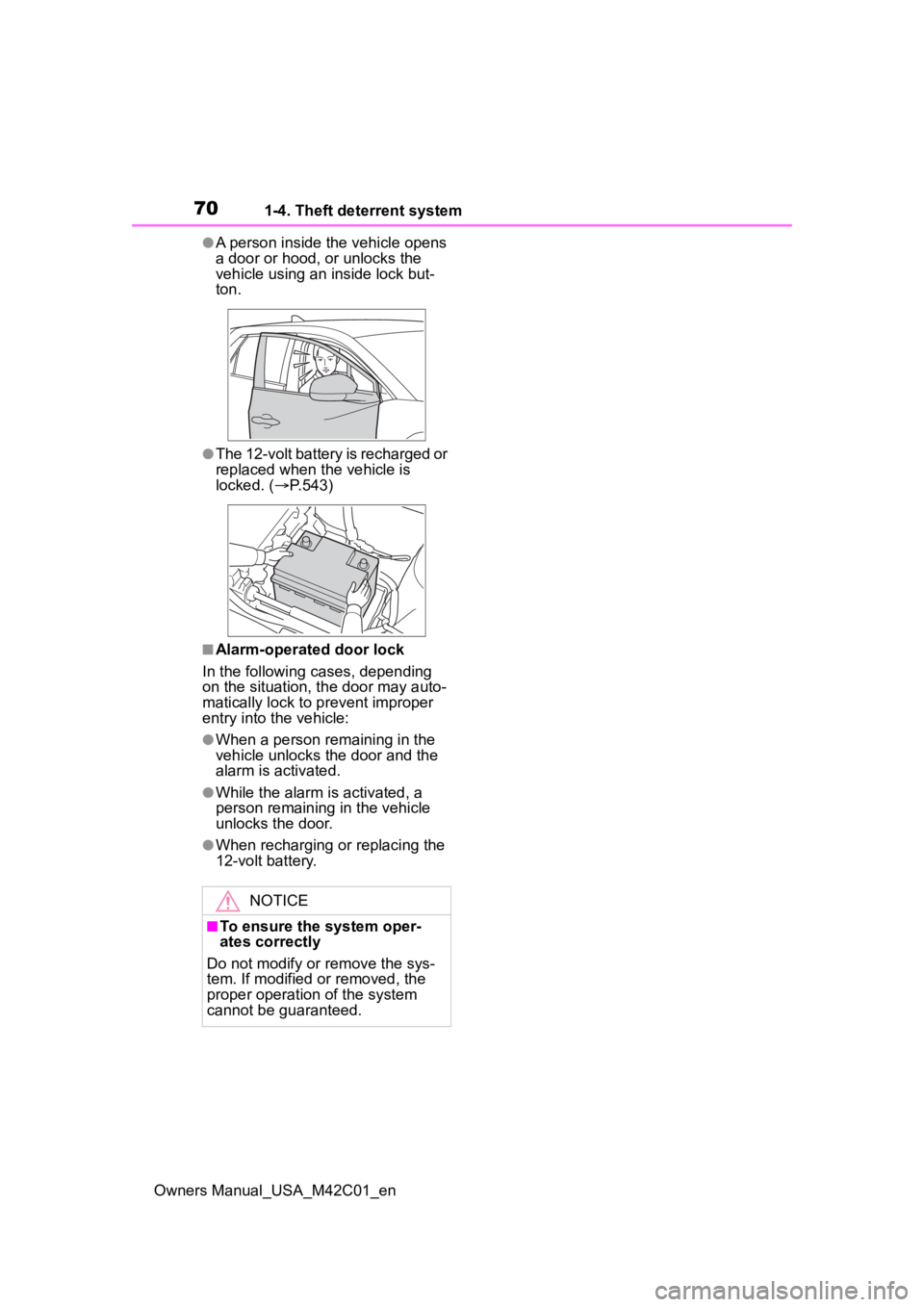
701-4. Theft deterrent system
Owners Manual_USA_M42C01_en
●A person inside the vehicle opens
a door or hood, or unlocks the
vehicle using an inside lock but-
ton.
●The 12-volt battery is recharged or
replaced when the vehicle is
locked. (P.543)
■Alarm-operated door lock
In the following cases, depending
on the situation, th e door may auto-
matically lock to p revent improper
entry into the vehicle:
●When a person remaining in the
vehicle unlocks the door and the
alarm is activated.
●While the alarm is activated, a
person remaining in the vehicle
unlocks the door.
●When recharging or replacing the
12-volt battery.
NOTICE
■To ensure the system oper-
ates correctly
Do not modify or remove the sys-
tem. If modified or removed, the
proper operation of the system
cannot be guaranteed.
Page 71 of 628

71
Owners Manual_USA_M42C01_en
2
2
Electric Vehicle system
Electric Vehicle system
2-1. Electric vehicle systemElectric Vehicle system fea-tures ............................. 72
Electric Vehicle system pre- cautions ........................ 76
Battery Electric Vehicle driv- ing tips .......................... 81
Driving range.................. 83
2-2. Charging Charging equipment....... 85
AC charging cable.......... 87
Locking and unlocking AC charging connector....... 93
Power sources that can be used ............................. 96
Charging methods.......... 98
Charging tips ............... 100
Things to know before charging .................... 102
How to use AC charging .................................. 105
How to use DC charging .................................. 113
Using the charging schedule function...................... 118
Using My Room Mode 129
When charging cannot be carried out ................. 133
Page 72 of 628
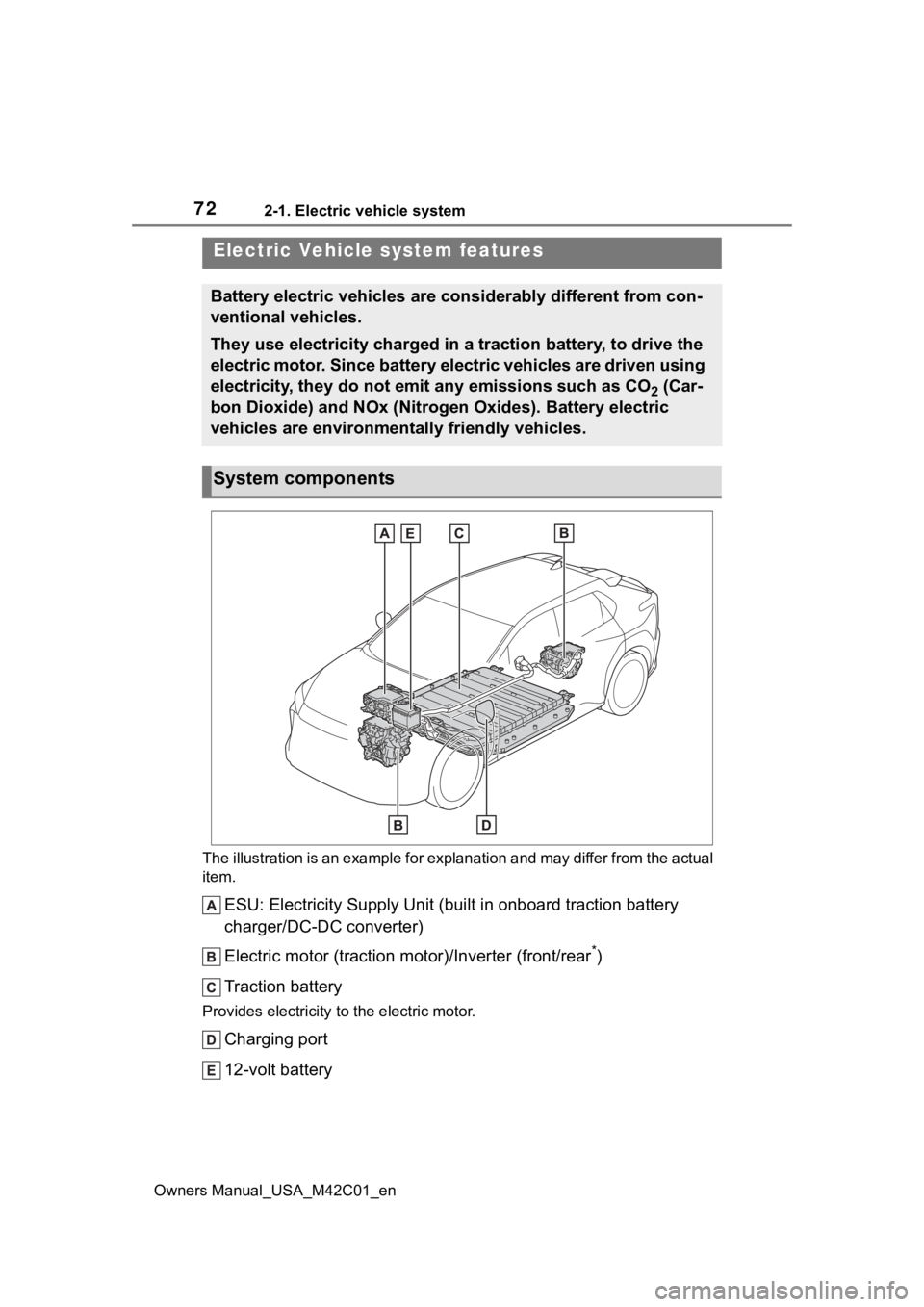
722-1. Electric vehicle system
Owners Manual_USA_M42C01_en
2-1.Electric vehicle system
The illustration is an example for explanation and may differ from the actual
item.
ESU: Electricity Supply Unit (built in onboard traction battery
charger/DC-DC converter)
Electric motor (traction motor)/Inverter (front/rear
*)
Traction battery
Provides electricity t o the electric motor.
Charging port
12-volt battery
Electric Vehicle system features
Battery electric vehicles are considerably different from con-
ventional vehicles.
They use electricity charged in a traction battery, to drive th e
electric motor. Since battery electric vehicles are driven using
electricity, they do not emit any emissions such as CO
2 (Car-
bon Dioxide) and NOx (Nitrogen Oxides). Battery electric
vehicles are environmentally friendly vehicles.
System components
Page 73 of 628
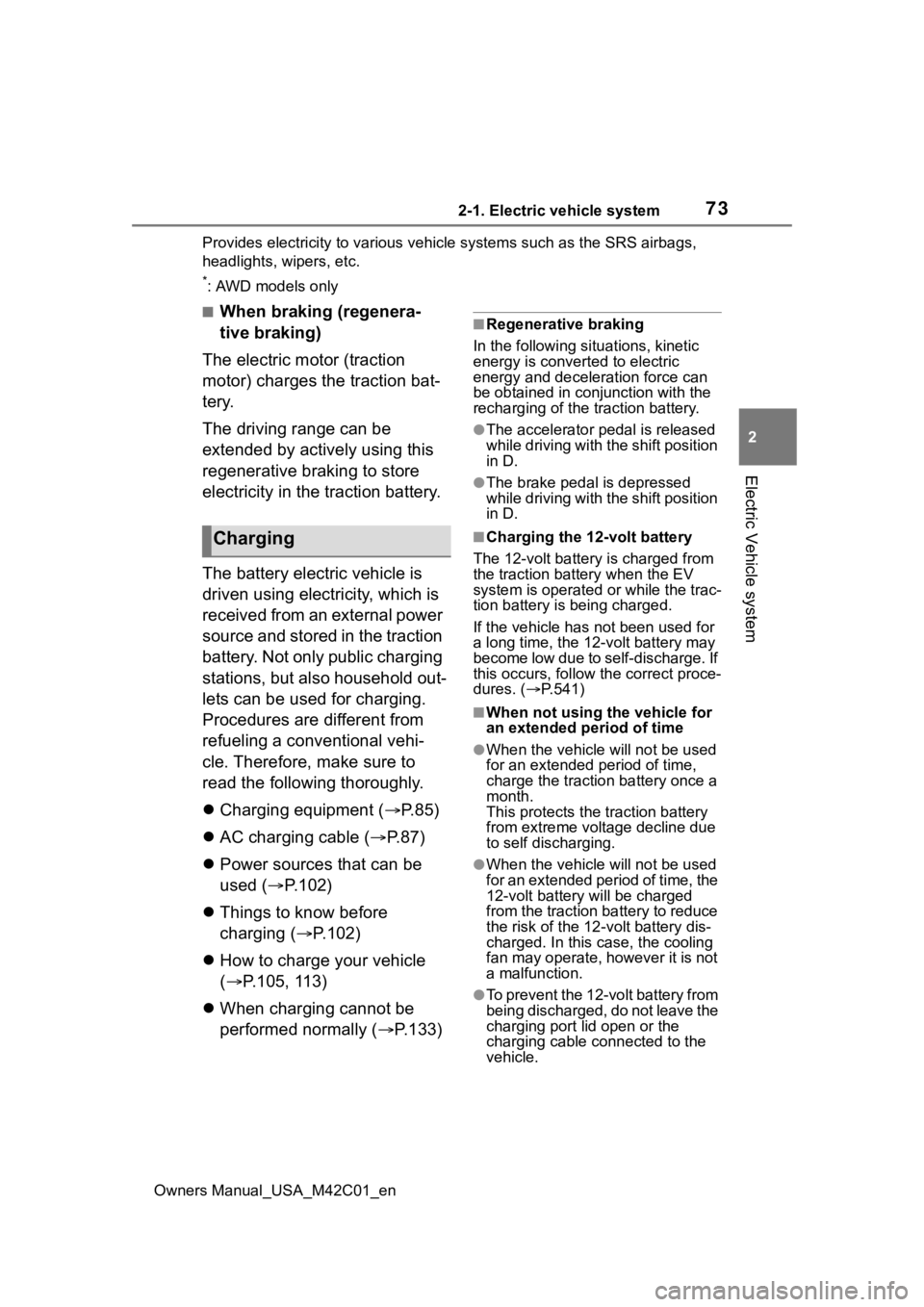
732-1. Electric vehicle system
Owners Manual_USA_M42C01_en
2
Electric Vehicle system
Provides electricity to various vehicle systems such as the SRS airbags,
headlights, wipers, etc.
*: AWD models only
■When braking (regenera-
tive braking)
The electric motor (traction
motor) charges the traction bat-
tery.
The driving range can be
extended by actively using this
regenerative braking to store
electricity in the traction battery.
The battery electric vehicle is
driven using electricity, which is
received from an external power
source and stored in the traction
battery. Not only public charging
stations, but also household out-
lets can be used for charging.
Procedures are different from
refueling a conventional vehi-
cle. Therefore, make sure to
read the following thoroughly.
Charging equipment ( P.85)
AC charging cable ( P. 8 7 )
Power sources that can be
used ( P.102)
Things to know before
charging ( P.102)
How to charge your vehicle
( P.105, 113)
When charging cannot be
performed normally ( P.133)■Regenerative braking
In the following situ ations, kinetic
energy is converted to electric
energy and deceler ation force can
be obtained in con junction with the
recharging of the traction battery.
●The accelerator pedal is released
while driving with the shift position
in D.
●The brake pedal is depressed
while driving with the shift position
in D.
■Charging the 12-volt battery
The 12-volt battery is charged from
the traction battery when the EV
system is operated or while the trac-
tion battery is being charged.
If the vehicle has not been used for
a long time, the 12- volt battery may
become low due to self-discharge. If
this occurs, follow the correct proce-
dures. ( P.541)
■When not using t he vehicle for
an extended period of time
●When the vehicle will not be used
for an extended period of time,
charge the traction battery once a
month.
This protects the traction battery
from extreme voltage decline due
to self discharging.
●When the vehicle will not be used
for an extended period of time, the
12-volt battery will be charged
from the traction battery to reduce
the risk of the 12- volt battery dis-
charged. In this c ase, the cooling
fan may operate, however it is not
a malfunction.
●To p r e v e n t t h e 1 2 - v o l t b a t t e r y f r o m
being discharged, do not leave the
charging port lid open or the
charging cable connected to the
vehicle.
Charging
Page 74 of 628

742-1. Electric vehicle system
Owners Manual_USA_M42C01_en
■Charging the traction battery
Be sure to maintain the traction bat-
tery charge level suitable for your
driving needs.
If the traction battery fully dis-
charges, the vehicle cannot be
driven at all. When the battery
becomes low, charge it as soon as
possible.
■If the traction battery becomes
low
●If the traction battery becomes
low, the traction battery charge
warning light comes on or flashes
and a message will be displayed
on the multi-information display.
( P.515)
●If the traction batte ry is completely
discharged, the EV system cannot
be started and dri ving will not be
possible. When the traction bat-
tery becomes low, charge it as
soon as possible.
■Sounds and vibrations specific
to an battery electric vehicle
Because there is no engine sound
or vibration, it is easy to mistake the
battery electric vehi cle for being off
when it is actually still running, as
indicated by the “READY” indicator
being illuminated. F or safety, make
sure to always shift the shift position
to P and apply the parking brake
when parked.
Before and after the EV system is
started, the following sounds and
vibrations may occur. However,
these sounds and/o r vibrations are
not signs of malfunctions:
●The brake system operation
sound may be heard from the
front of the vehicle when the
driver’s door is opened.
●Motor sounds may be heard from
the motor compartment or lug-
gage compartment.
●Electrical relay sounds may be
heard from the motor compart-
ment when the EV system starts or stops.
●Relay operating sounds such as a
snap or soft clank will be emitted
from the traction b
attery in the fol-
lowing situations:
• When the EV system is started or stopped
• When charging starts or com-
pletes
• When the vehicle is driven the first time after the traction battery has
been charged using DC charging
●Sounds may be heard due to
regenerative braking when the
brake pedal is depressed or as
the accelerator pedal is released.
●Cooling fan operating sounds
from the radiator.
●The operation sound of the air
conditioning system (air condition-
ing compressor, blower motor).
■Maintenance, repair, recycling,
and disposal
Contact your Toyota dealer regard-
ing maintenance, repair, recycling
and disposal. Do n ot dispose of the
vehicle yourself.
A sound which changes in
accordance with the driving
speed, will be played in order to
warn people nearby of the vehi-
cle’s approach. This sound may
be heard inside the vehicle. The
sound will stop when the vehicle
speed exceeds approximately
23 mph (37 km/h).
■Acoustic Vehicle Alerting Sys-
tem
In the following cases, the Acoustic
Vehicle Alerting System may be dif-
ficult for surrounding people to hear.
Acoustic Vehicle Alerting
System
Page 76 of 628

762-1. Electric vehicle system
Owners Manual_USA_M42C01_enThe illustration is an example fo
r explanation and may differ from the actual
item.
Warning label
High voltage cables (orange)
ESU: Electricity Supply Unit (built in onboard traction battery
charger/DC-DC converter)
Service plug
AC charging inlet
Electric Vehicle system precautions
Be careful of the high voltage components (nominal voltage
at 355.2 V), such as the traction battery, electricity supply
unit, orange colored high voltage cables, and electric motor,
as well as high temperature components such as the cooling
radiator, which are provided on the battery electric vehicle.
For the high voltage components, warning labels are pro-
vided on them. Read them when they need to be handled.
System components
Page 77 of 628
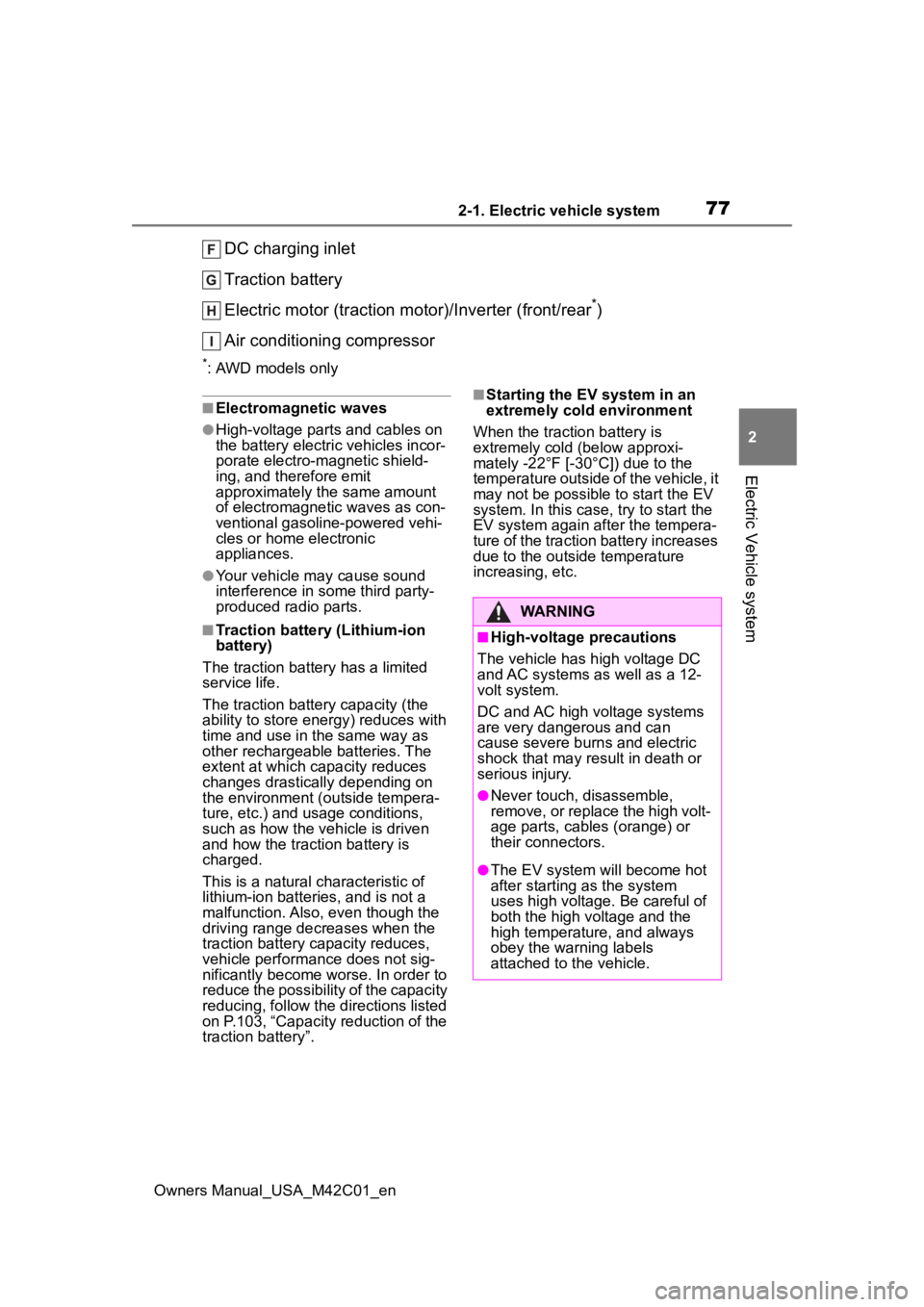
772-1. Electric vehicle system
Owners Manual_USA_M42C01_en
2
Electric Vehicle system
DC charging inlet
Traction battery
Electric motor (traction motor)/Inverter (front/rear
*)
Air conditioning compressor
*: AWD models only
■Electromagnetic waves
●High-voltage parts and cables on
the battery electric vehicles incor-
porate electro-magnetic shield-
ing, and the refore emit
approximately the same amount
of electromagnetic waves as con-
ventional gasoli ne-powered vehi-
cles or home electronic
appliances.
●Your vehicle may cause sound
interference in so me third party-
produced radio parts.
■Traction battery (Lithium-ion
battery)
The traction batte ry has a limited
service life.
The traction battery capacity (the
ability to store ene rgy) reduces with
time and use in the same way as
other rechargeable batteries. The
extent at which capacity reduces
changes drastically depending on
the environment (outside tempera-
ture, etc.) and us age conditions,
such as how the vehicle is driven
and how the traction battery is
charged.
This is a natural characteristic of
lithium-ion batteries, and is not a
malfunction. Also, even though the
driving range decreases when the
traction battery capacity reduces,
vehicle performance does not sig-
nificantly become worse. In order to
reduce the possibility of the capacity
reducing, follow the directions listed
on P.103, “Capacity reduction of the
traction battery”.
■Starting the EV system in an
extremely cold environment
When the traction battery is
extremely cold (below approxi-
mately -22°F [-30°C]) due to the
temperature outside of the vehicle, it
may not be possible to start the EV
system. In this case, try to start the
EV system again after the tempera-
ture of the traction battery increases
due to the outside temperature
increasing, etc.
WARNING
■High-voltage precautions
The vehicle has high voltage DC
and AC systems as well as a 12-
volt system.
DC and AC high voltage systems
are very dangerous and can
cause severe burns and electric
shock that may result in death or
serious injury.
●Never touch, disassemble,
remove, or replace the high volt-
age parts, cables (orange) or
their connectors.
●The EV system will become hot
after starting as the system
uses high voltage. Be careful of
both the high voltage and the
high temperature, and always
obey the warning labels
attached to the vehicle.